|
It really is amazing
how quickly aeronautics evolved in the mere four decades between when the Wright
brothers first flew their Flyer until when this 1945 issue of Flying Age
magazine printed a history of development of propellers. The technology went from
fixed pitch, hand-carved wooden models to variable pitch, machine formed and finished
high strength metal alloy variants. Those c1945 props needed to withstand the incredible
forces of not just 1000-plus horsepower engines, but the centrifugal force and bending
moments imposed on them by high speed rotation and rapid changes in axial orientation
as the airplanes they were attached to performed high−G maneuvers. Research and
development from American, European, Russian, Chinese, and Japanese engineers and
scientists are to be primarily credited - and thanked - for their brilliance and
hard work.
Decade of Progress
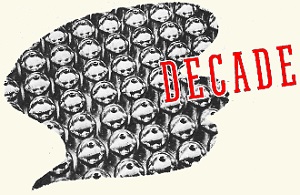 The last ten years, most vital in aviation history,
have done just as much for the "windmill" up in front. The last ten years, most vital in aviation history,
have done just as much for the "windmill" up in front.
During the past ten years, aircraft advances have piled up so impressively that
they put their previous three decades of successful history to shame. And among
the most important developments which have influenced and contributed most to aviation
progress has been the controllable, constant speed propeller.
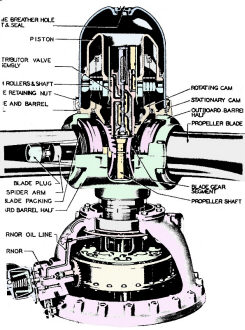
A cutaway drawing of the hub and mechanism of the Hamilton Standard
hydromatic propeller. It is worked by an hydraulic drive and governor.
Let's take another look at what makes the propeller work and what influences
it while it's working. When an airplane is held stationary and the prop is rotating
at high speed, the air being given momentum impinges upon the face of the blades
in a manner acting to bend the blades, push the propeller off its shaft or, since
these latter efforts don't really succeed very well, pull the airplane off the ground
and into flight. Static thrust, or the maximum pull exerted by the propeller when
the airplane is stationary, gradually lessens as the plane gains momentum and takes
off. The force developed by the propeller in translating engine power into propulsive
work is called thrust.
Thrust has a bending effect on the prop. But centrifugal force acts to keep the
blades pulled out straight. The result of these two forces is to keep the blades
slightly tilted forward when the propeller is operating. So this tilt, or "rake"
is often built into a propeller by using a construction angle which is calculated
to approximate that result and thus make the blade easier to rotate when loads are
imposed.
Torque is a function of engine power which is transmitted into thrust by the
propeller. It's direct-ly proportional to engine power and thus inversely proportional
to propeller r.p.m. As the plane gathers momentum, the torque which tends to rock
the engine in an airplane in a direction opposite to the rotation of the propeller,
is acting at the propeller shaft in such a way that it constitutes a source of pitch-changing
power.
These forces (with the negative force of vibration which is, perhaps, the propeller's
worst enemy) are the principal forces acting upon a propeller. And, except for vibration,
they can all be used to change blade angles according to the aircraft and engine
speeds and engine attitudes. To get the angle change is not a particularly hard
problem, but to balance the forces which, control it so that the maximum benefit
of variable pitch is obtained is a weighty problem. The history of propeller progress
during the past historical ten years is the tale of the engineering and construction
of such a mechanism which is both rugged and sensitive.
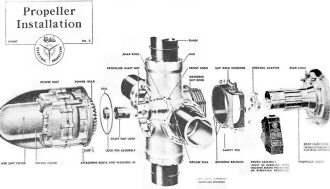
Installation of the Curtiss electric propeller. It has its own
reversible electric motor, seven major assemblies.
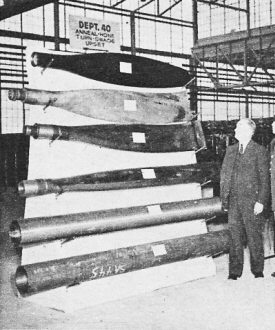
Steps, bottom to top, in producing one-piece steel prop blade
at American Propeller Corp. It is all precision ground.
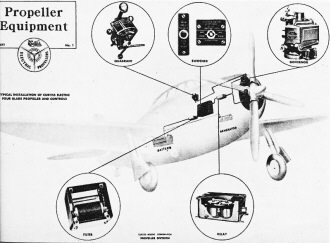
The control system of the electric prop switches the current
to the prop motor. Speed reducer converts power to prop force.
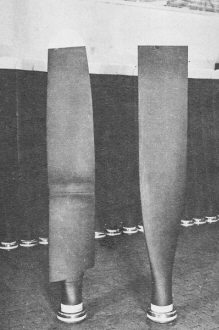
Example of prop modification is square-tipped Hamilton Standard
developed for P-51 to absorb higher horsepower rating.
Let's consider the story as based on main developments of one of the largest
propeller manufacturers, Hamilton Standard Propellers Division of United Aircraft.
We 'suggest you take a twelve-inch ruler in your hand as you read this. Consider
the ruler to be a guide governing the range of propeller blade pitch change with
the six-inch station the point at which the fixed-pitch propeller stands. The fixed-pitch
propeller, as we've said above, has no adjustability, and, therefore, its blade
pitch is about the best possible compromise between the propeller requirements for
takeoff and those for cruising.
From the six-inch point, you move in each direction to record gains in blade-pitch
range. Thus, for the old adjustable propeller, which could be adjusted on the ground
only for desired flight conditions, you would cover the range between the five-
and seven-inch stations. Then, in 1932, Hamilton Standard brought out its controllable
propeller, which moves the boundaries of blade-pitch range much farther, to, let's
say, the three-and-a-half and eight-and-a-half-inch stations. Along comes the company's
hydromatic propeller in 1938, and the range increases to the two-inch and ten-inch
stations.
Consider the one-inch station to be take-off requirements and the eleven-inch
station as diving requirements. That represents the hydromatic range of about forty-five
degrees change in blade-pitch angle. Go to the half-inch station and you run into
flat pitch. Beyond that is reversing. At the other end of the scale would be feathering
beyond the twelve-inch station.
In the first controllable propeller designed by Hamilton Standard in 1932, a
successful attempt was made to assure production of full rated engine horsepower
at full rated r.p.m. without exceeding rated manifold pressure.
The Propeller Division of Curtiss-Wright also claims the honor of producing the
first controllable propeller. Then the Curtiss Aeroplane and Motor Co. the corporation
acquired, in 1928, an electrically-operated propeller, developed independently by
W. Turnbull. After a lot of research, the first Curtiss electric propeller was produced
in 1930.
These two companies are the major producers of the two most effective methods
of mechanical control: hydraulic and electric. They have been in the research vanguard
which eventually resulted in the modern propeller with its triple functions: constant
speed for normal operation; feathering for emergency use; and reversing for braking
during landing (see following page).
During the past decade, too, such great advance has been made in it factor of
propellers - ice - that de-icing equipment is a requirement of any modern, large
propeller. Preferred methods now follow two major trends: electrical, using a resistance
element attached to the leading edge; and heated air, introduced into the inside
of a hollow metal blade and exhausted at the tip.
Now that jet propulsion has plummeted into the aeronautical picture, it may well
be quizzically asked, "Well, what's going to happen to propellers?" Actually, the
most interesting aspect is the similarity of the two systems. Both give thrust to
the aircraft by imparting backward momentum to the air on which they work. It's
the same principle: the change in momentum of an air mass. According to the propeller
people, however, the jet engine gives a high velocity to a relatively small mass
of air, while the propeller adds a small measure of velocity to a large mass of
air. This means that the maximum efficiency of the jet occurs at extremely high
speeds and that at low speeds the efficiency is low. The propeller, on the other
hand, gives good efficiency at low speeds and also at high speeds, at least up to
the point where the compressibility factor flies in the window.
To produce a given thrust, the propeller, whether it's driven by a piston engine
or a jet turbine, will be ahead of the jet from the standpoint of thrust per pound
of fuel burned up until the vicinity of 600 m.p.h. and more, the exact value of
this speed depending, on, the one hand, on how rapidly compressibility affects propeller
efficiency and, on the other, how low jet engine fuel consumption can be obtained.
Since the economics of air transportation and the efficiency of military operations
are greatly affected by fuel economy - fuel weight is frequently larger than pay-load
- it is evident that the propeller-powered aircraft will continue as long as it
gives greater fuel economy than a jet powerplant.
Posted May 20, 2022
|